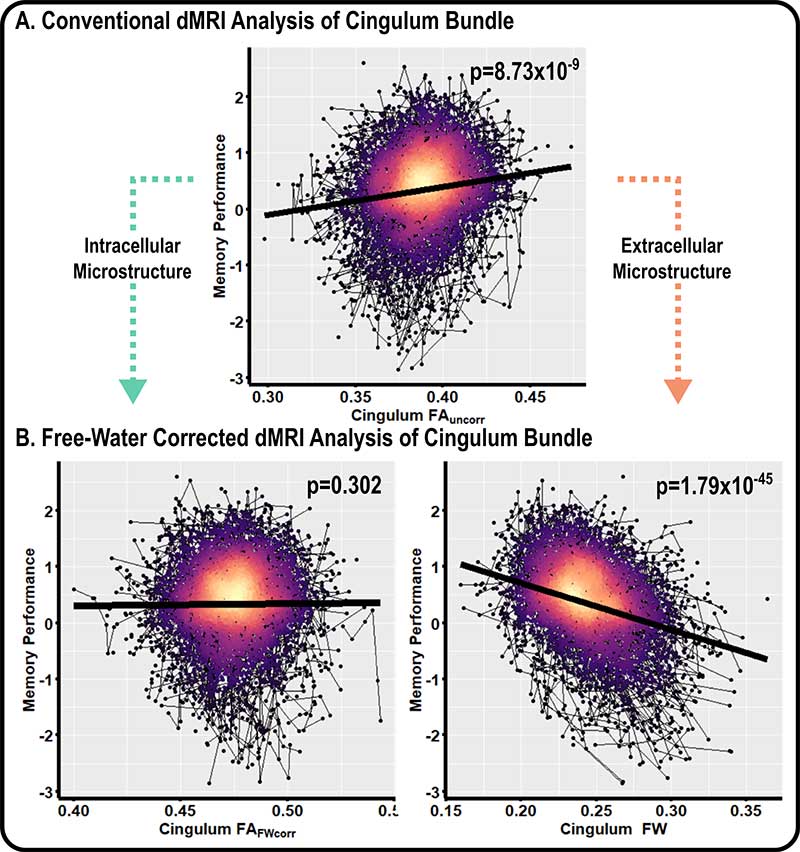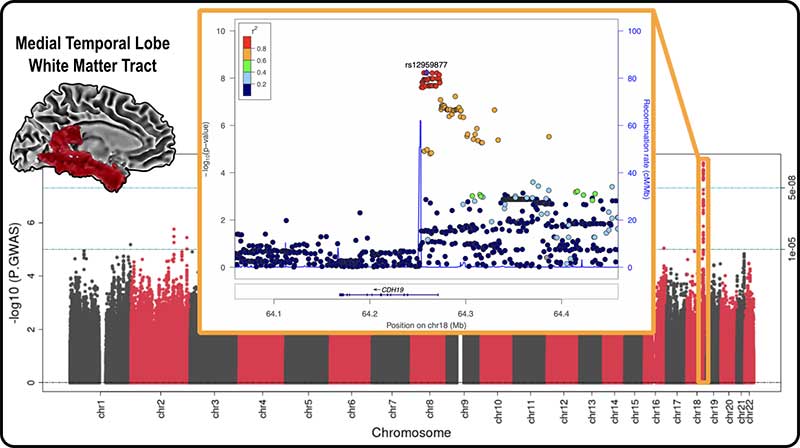While significant strides have been made in developing amyloid-clearing drugs in AD, current evidence suggests that targeting additional pathways beyond amyloidosis is imperative for effective therapeutic interventions. Our work builds on these needs by focusing on white matter microstructure in aging and AD, which is crucial for understanding global brain vulnerabilities. Fully exploiting brain neurodegeneration by assessing both gray and white matter abnormalities may provide more sensitive prediction of individuals at risk for AD and may also allow for the discovery of novel target genes in AD, potentially revolutionizing therapeutic interventions.
Exploring the Role of White Matter Along the AD Clinical Spectrum
Research from our group has begun using large-scale, harmonized diffusion MRI data to understand white matter changes along the AD clinical spectrum. Specifically, we use free-water post-processing algorithms on single-shell derived diffusion MRI data in conjunction with high resolution tractography templates to quantify microstructure in dozens of white matter tracts. Focusing on specific white matter tracts vulnerable along the AD continuum can provide additional insight into the neurodegenerative processes in AD.

Figure 1. A comprehensive analysis of white matter abnormalities along the AD clinical continuum (cognitively unimpaired, mild cognitive impairment, and AD) found that limbic tracts are particularly vulnerable. Further, we have found that the free-water measure itself has high detection capabilities. (Yang et al. 2023, Alzheimer’s & Dementia: Diagnosis, Assessment, and Disease Monitoring)
Characterizing White Matter Associations with Cognitive Decline in Aging and AD
Collaborations within the Alzheimer’s Disease Sequencing Project Phenotype Harmonization Consortium (ADSP-PHC), in addition to several other longstanding cohorts of aging and AD, allow us to pair harmonized diffusion MRI data with harmonized cognitive data in thousands of participants. This allows us to evaluate the white matter associations with cognitive performance and decline across multiple domains.

Figure 2. The cingulum bundle, a white matter tract which has shown high vulnerability in aging and AD, demonstrates sensitive conventional fractional anisotropy (FAuncorr) associations with longitudinal memory performance; however, following free-water correction, the intracellular association (i.e., FAFWcorr) is mitigated. Interestingly, the free-water (FW) component is even more significant than the FAuncorr measure, agreeing with prior literature that the FW measure is sensitive to neurodegenerative effects in aging.
Conducting Large-Scale Imaging Genetic Analysis
We can pair our large-scale imaging database with genetic data to conduct computational genetics pipelines. This work will highlight candidate pathways in white matter and begin to characterize the mechanisms driving abnormalities in diffusion MRI measures in aging and AD. This focus could move the field towards more comprehensive treatments for neurodegeneration in aging and AD.

Figure 3. A Manhattan plot (n=2,614) demonstrating a significant association with medial temporal lobe microstructure on chromosome 18 (rs12959877, MAF=0.444, p=5.78x10-9).
Relevant Publications
- D.B. Archer, K.G. Schilling, N. Shashikumar, V. Jasodanand, E.E. Moore, K.R. Pechman, M. Bilgel, L.L. Beason-Held, Y. An, A.T. Shafer, S.L. Risacher, B.A. Landman, A.L. Jefferson, A.J. Saykin, S.M. Resnick, T.J. Hohman, for the Alzheimer’s Disease Neuroimaging Initiative. (2023) Leveraging longitudinal diffusion MRI data to quantify differences in white matter microstructural decline in normal and abnormal aging. Alzheimer’s & Dementia: Diagnosis, Assessment, and Disease Monitoring, 15 (4) e12468. PMCID: 10540270
- K. G. Schilling, D.B. Archer, F. Rheault, I. Lyu, Y. Huo, L.Y. Cai, S. Bunge, J.C. Gore, A.W. Anderson, B.A. Landman. (2023) Superficial white matter across the lifespan: volume, thickness, percent change, and relationship with cortical features. Brain Structure and Function, 228 (3), 1019-1031. PMCID: 10320929
- Y. Yang, K.G. Schilling, N. Shashikumar, V. Jasodanand, E.E. Moore, K.R. Pechman, M. Bilgel, L.L. Beason-Held, Y. An, A.T. Shafer, S.L. Risacher, B.A. Landman, A.L. Jefferson, A.J. Saykin, S.M. Resnick, T.J. Hohman, D.B. Archer, for the Alzheimer’s Disease Neuroimaging Initiative. (2023) White matter microstructural metrics are sensitively associated with clinical staging in Alzheimer’s disease. Alzheimer’s & Dementia: Diagnosis, Assessment, and Disease Monitoring, 15 (2) e12425. PMCID: 10192723
- K.G. Schilling, D.B. Archer, F.C. Yeh, F. Rheault, L.Y. Cai, A.T. Shafer, S.M. Resnick, T.J. Hohman, A.L. Jefferson, A.W. Anderson, H. Kang, B.A. Landman. (2023) Short superficial white matter and aging: a longitudinal multi-site study of 1293 subjects and 2711 sessions. Aging Brain, 3, 100067. PMCID: 9937516
- D.E. Gustavson, D.B. Archer, J.A. Elman, O.K. Puckett, C. Fennema-Notestine, M.S. Panizzon, N. Shashikumar, T.J. Hohman, A.L. Jefferson, L.T. Eyler, L.K. McEvoy, M.J. Lyons, C.E. Franz, W.S. Kremen. (2022) Associations among executive function abilities, free water, and white matter microstructure in early old age. NeuroImage: Clinical, 37, 103279. PMCID: 9731853.
- K.G. Schilling, D. B. Archer, F.C. Yeh, F. Rheault, L.Y. Cai, C. Hansen, Q. Yang, K. Ramdass, A.T. Shafer, S.M. Resnick, K.R. Pechman, K.A. Gifford, T.J. Hohman, A.L. Jefferson, A.W. Anderson, H. Kang, B.A. Landman. (2022) Aging and white matter microstructure and macrostructure: a longitudinal multi-site diffusion MRI study of 1218 participants. Brain Structure and Function, 227, 2111-2125. PMCID: 9648053
- D.B. Archer, E.E. Moore, U. Pamidimukkala, N. Shashikumar, K.R. Pechman, K. Blennow, H. Zetterberg, B.A. Landman, T.J. Hohman, A.L. Jefferson, K.A. Gifford. (2021) The relationship between white matter microstructure and self-perceived cognitive decline. NeuroImage: Clinical, 32, 102794. PMCID: 8414539
- D.B. Archer, E.E. Moore, N. Shashikumar, L. Dumitrescu, K.R. Pechman, B.A. Landman, K. Gifford, A.L. Jefferson, T.J. Hohman. (2020) Free-water metrics in medial temporal lobe white matter tract projections relate to longitudinal cognitive decline. Neurobiology of Aging, 94, 15-23. PMCID: 7483422
Collaborators
- Timothy Hohman
- Logan Dumitrescu
- Angela Jefferson
- Bennett Landman
- Kurt Schilling
- Yuankai Huo
- Daniel Moyer
- The Alzheimer’s Disease Sequencing Project
- Vanderbilt Brain Institute
- Vanderbilt Genetics Institute